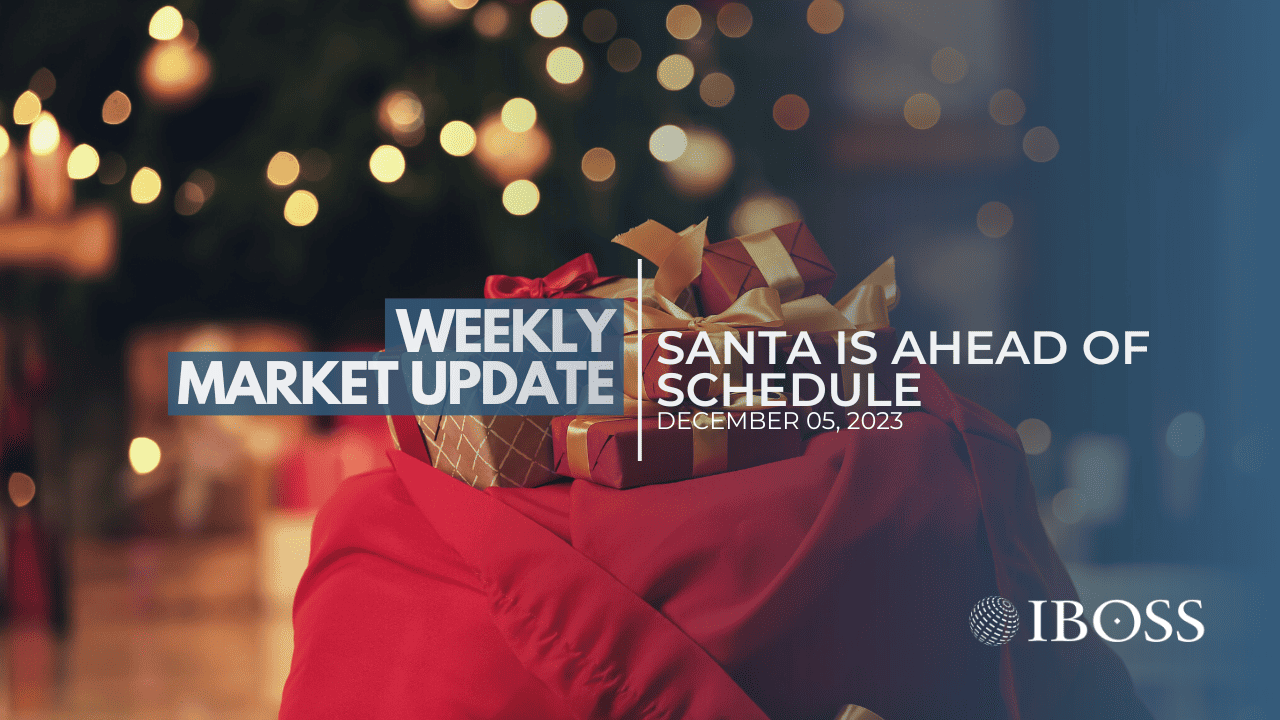
The Santa rally continued last week with global equities rising a further 0.7%. More impressively, equity markets chalked up in November their largest gain for three years, returning as much as 8.0% in local currency terms. However, the gains were rather smaller for UK investors, with markets up a mere 4.7% in sterling terms. UK large cap stocks also lagged with a 2.3% return, although small and mid-cap fared better with gains of 4-7%.
Fixed income has also rallied sharply with government bond yields retreating last week a further 0.3% in the US and 0.1% in the UK, leading to returns of 1.7% and 1.0% respectively. November was the best month for US bonds in 40 years. 10-year US Treasury yields are back down to 4.25% from an October high of 5.0%. The rally has not been confined to mainstream assets. Gold has broken above its previous highs, touching $2100 earlier today.
The driving force behind all these gains has been the dramatic reappraisal by the market of the interest rate outlook. Whereas back in October, the markets were spooked by the prospect of rates remaining higher for longer, now they are convinced they will be cut significantly next year.
Markets assume rates in the US and Eurozone will start to fall in the spring and be a full 1.25% lower by end-year. In the UK, rate cuts are expected to be a bit slower with easing starting early summer and rates falling from 5.25% to 4.5%.
The turnaround in sentiment has been driven primarily by increased hopes of a soft-landing following better than expected inflation data. Last week saw further favourable news on this front. The Fed’s favourite measure showed the headline and core inflation rates falling to 3.0% and 3.5% respectively in October, despite growth running at a surprisingly strong 5.2% annualised pace in the third quarter.
The good news has not been confined to the US. Inflation has also slowed sharply in the Eurozone with the headline rate in November declining to 2.4% and the core rate to 3.6%. This improvement is arguably less of a surprise as, unlike the US, the Eurozone economy has been flatlining and dabbling with recession for a year now.
Equally important has been the central bank reaction to the better inflation news and improvement in market sentiment. Whereas central bankers were recently all very much speaking from the same ‘higher for longer’ hymn sheet, now there is a rather greater divergence in opinion both at the Fed and the ECB on how soon rates can be cut.
Chair Powell, unlike some other Fed officials, attempted last week to pour some cold water on the idea that rate cuts next year are baked into the cake but didn’t do so sufficiently robustly to dent the market’s confidence. OPEC also attempted to boost the oil price by extending and increasing their production cuts. But again, the move was viewed as half-hearted and the Brent oil price has slipped back below $80/bbl.
So where does this all leave us? In a nutshell, pretty much back to where we were mid-summer. Equities have reversed their autumn sell-off and are back up around their end-July highs in both local currency and sterling terms. Treasury yields and interest rate expectations have also gone full circle and are back to their July levels.
Recent inflation news has undoubtedly been considerably better than expected and rate cuts in the second half of next year are now looking very likely in the US, Eurozone and UK. That said, it is far from clear that rates will be reduced as fast as the market is now presuming. The big post-covid forecasting misses of economists, strategists, central bankers and markets mean one should treat what is heralded as the latest gospel truth by any or all of these soothsayers with some scepticism.
Even if the Santa rally is now looking somewhat overdone, we still believe bonds and equities will outperform cash from here over the next year or two. The rally has highlighted how attempting to fine tune a move out of cash back into riskier assets is a dangerous game given the risk that markets jump the gun and much of the gains occur sooner rather than later.
This communication is designed for professional financial advisers only and is not approved for direct marketing with individual clients. These investments are not suitable for everyone, and you should obtain expert advice from a professional financial adviser. Investments are intended to be held over a medium to long term timescale, taking into account the minimum period of time designated by the risk rating of the particular fund or portfolio, although this does not provide any guarantee that your objectives will be met. Please note that the content is based on the author’s opinion and is not intended as investment advice. It remains the responsibility of the financial adviser to verify the accuracy of the information and assess whether the OEIC fund or discretionary fund management model portfolio is suitable and appropriate for their customer.
Past performance is not a reliable indicator of future performance. The value of investments and the income derived from them can fall as well as rise, and investors may get back less than they invested.
IBOSS Asset Management is authorised and regulated by the Financial Conduct Authority. Financial Services Register Number 697866.
IBOSS Asset Management Limited is owned by Kingswood Holdings Limited, an AIM Listed company incorporated in Guernsey (registered number: 42316).
Registered Office: 2 Sceptre House, Hornbeam Square North, Harrogate, HG2 8PB. Registered in England No: 6427223.
IAM 336.12.23

